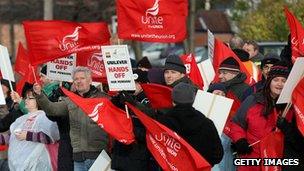Union membership has halved since 1980
- Published

There have been a number of union protests in the past year
Trade union membership has fallen below six million for the first time since the 1940s.
There are now 5.98 million members of TUC-affiliated unions, which is fewer than half the number just 30 years ago.
The TUC blames the fall on job cuts in the public sector.
Trade union ranks soared in the post-war years. By the end of the 1970s - a decade of widespread industrial unrest - more than 12 million workers were paying their subs.
According to TUC figures, union membership peaked in 1980 at 12.2million.
By then, Margaret Thatcher was in power. In the years that followed, union legislation was tightened and traditional manufacturing industries declined.
Union membership plummeted during successive Conservative governments and the trend continued under New Labour, albeit at a lower rate.
Since the start of the financial crisis in 2008, membership has declined by more than half a million.
The TUC said that the fall in membership was "a direct result of redundancies particularly in the public sector".
"The private sector lost jobs at the start of the recession but government spending cuts now aim to reduce the public sector workforce by up to a million," a spokesperson added.
'Special treatment'
But some will see the decline as evidence that unions have become less relevant.
"Since the 1980s, when the unions lost their privileged position, they have struggled to reinvent themselves," said Ruth Porter of the Institute of Economic Affairs, a free-market think tank.
"A focus on campaigning for special treatment for their members through striking has made unions increasingly irrelevant. Their action over public sector pension reform is a good example of this."
The news comes as union delegates gather for the 144th annual TUC Congress. They are expected to hear repeated calls for coordinated industrial action to fight the government's austerity measures.
- Published7 September 2012
- Published7 September 2012